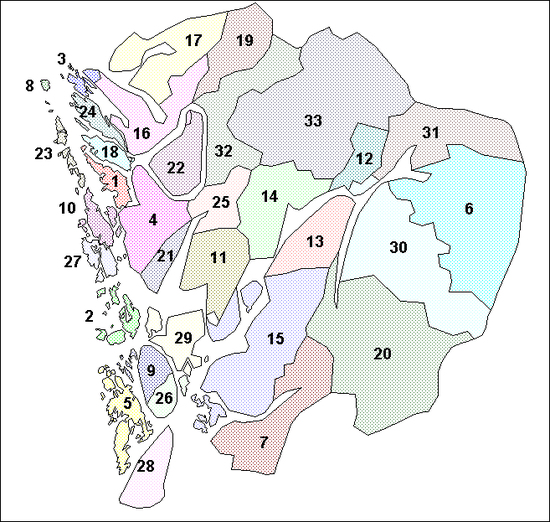Hordaland (Urban East Norwegian: [ˈhɔ̂rdɑlɑn] ) was a county in Norway, bordering Sogn og Fjordane, Buskerud, Telemark, and Rogaland counties. Hordaland was the third largest county, after Akershus and Oslo, by population. The county government was the Hordaland County Municipality, which is located in Bergen. Before 1972, the city of Bergen was its own separate county, apart from Hordaland. On 1 January 2020, the county was merged with neighbouring Sogn og Fjordane county, to form the new Vestland county.
Hordaland (Old Norse: Hǫrðaland) is the old name of the region which was revived in 1919. The first element is the plural genitive case of hǫrðar, the name of an old Germanic tribe (see Charudes). The last element is land which means "land" or "region" in the Norwegian language.
Until 1919 the name of the county was Søndre Bergenhus amt which meant "(the) southern (part of) Bergenhus amt". (The old Bergenhus amt was created in 1662 and was divided into Northern and Southern parts in 1763.)

Hordaland's flag shows two golden axes and a crown in red. The flag is a banner of the coat of arms derived from the old seal of the guild of St. Olav from Onarheim in Tysnes municipality. This seal was used by the delegates of Sunnhordland in 1344 on the document to install king Haakon V of Norway. It was thus the oldest symbol used for the region and adapted as the arms and flag in 1961. The symbols refer to the patron saint of the guild, Saint Olav, King of Norway, whose symbol is an axe.[4]
The coat-of-arms were officially granted on 1 December 1961. They were designed by Magnus Hardeland, but the general design had been originally used in the Sunnhordland region during the 14th century. In the early 20th century, leaders of the county began using the old arms as a symbol for the county once again. The arms are on a red background and consist of two golden axes that are crossed with a golden crown above them.[5]
Hordaland county had been around for more than one thousand years. In the 7th century, the area was made up of many petty kingdoms under the Gulating and was known as Hordafylke from around the year 900. In the early 16th century, Norway was divided into four len. The Bergenhus len was headquartered in Bergen and encompassed much of western and northern Norway.[10]
In 1662, the lens were replaced by amts. Bergenhus amt originally consisted of the present-day areas of Hordaland, Sogn og Fjordane, and Sunnmøre and the far northern Nordlandene amt was subordinate to Bergenhus. In the 1680s, Nordlandene and Sunnmøre were split from Bergenhus. In 1763, the amt was divided into northern and southern parts: Nordre Bergenhus amt and Søndre Bergenhus amt. When the amt was split, the present day municipality of Gulen was split with the southern part ending up in Søndre Bergenhus amt. In 1773, the border was re-drawn so that all of Gulen was located in the northern part. Søndre Bergenhus amt was renamed Hordaland fylke in 1919.[10]
The city of Bergen was classified as a city-county (byamt) from 1831 to 1972. During that time in 1915, the municipality of Årstad was annexed into Bergen. In 1972, the neighbouring municipalities of Arna, Fana, Laksevåg and Åsane were annexed into the city of Bergen. Also at that same time, the city of Bergen lost its county status, and became a part of Hordaland county.[10]

A county (fylke) is the chief local administrative area in Norway. The whole country is divided into 19 counties. A county is also an election area, with popular votes taking place every 4 years. In Hordaland, the government of the county was the Hordaland County Municipality. It included 57 members elected to form a county council (Fylkesting). Heading the Fylkesting was the county mayor (fylkesordførar). The last county mayor for the Hordaland County Municipality was Anne Gine Hestetun.
The county also had a County Governor (fylkesmann) who was the representative of the King and Government of Norway. Lars Sponheim was the last County Governor of Hordaland. The municipalities in Hordaland were divided among four district courts (tingrett): Nordhordland, Sunnhordland, Bergen, and Hardanger. Hordaland was also part of the Gulating Court of Appeal district based in Bergen.[10]
Most of the municipalities in Hordaland were part of the Hordaland police district. Gulen and Solund in Sogn og Fjordane county were also part of the Hordaland police district. Bømlo, Etne, Fitjar, Stord and Sveio were a part of the "Haugaland and Sunnhordland" police district, along with eight other municipalities in Rogaland county.[10]

Hordaland is semi-circular in shape. It is located on the western coast of Norway, split from southwest to northeast by the long, deep Hardangerfjorden, one of Norway's main fjords and a great tourist attraction. About half of the National park of Hardangervidda is in this county. The county also includes many well-known waterfalls, such as Vøringsfossen and Stykkjedalsfossen. It also includes the Folgefonna and Hardangerjøkulen glaciers.
More than 60% of the inhabitants live in Bergen and the surrounding area. Other urban or semi-urban centres include Leirvik, Voss and Odda.

Hordaland county is twinned with:[10]
Since 1949 Hordaland has given a Christmas tree to the Scottish Capital city of Edinburgh this is to remember the help given to Norwegians during World War II by Scots however since 2008 the tree has been sourced in Scotland but has remained a gift from the people of Hordaland.[13]